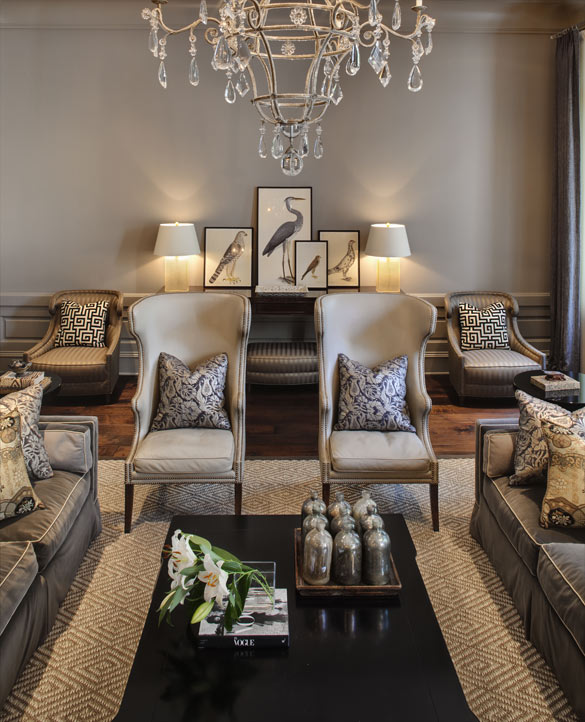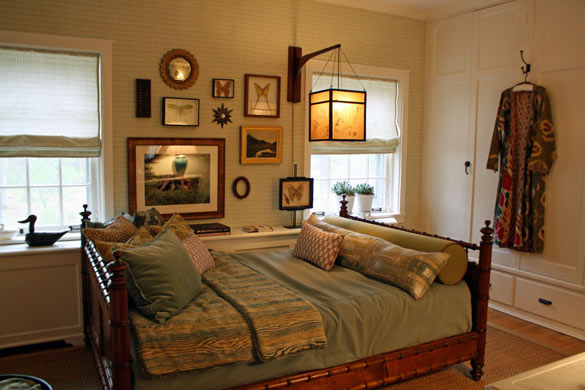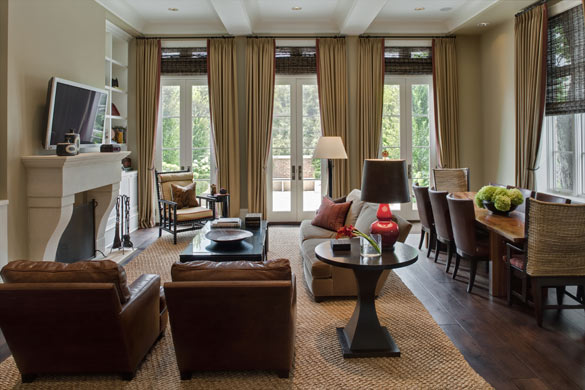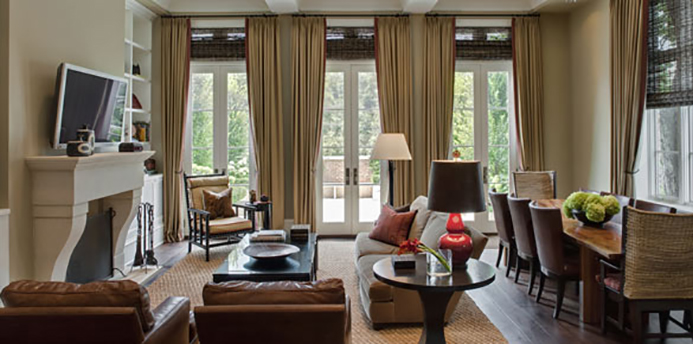No question, having “an eye” is a gift.
Most of us must turn to a professional to achieve just the right mix of furniture, textiles, color and accessories to beautifully furnish a space. But wouldn’t it be great to know how to do it yourself?
We asked three interior designers for their secrets to pulling together a room. What you’ll find is regardless of your style, many of the same rules apply. (Right photo: Decorated by Stephanie Wohlner; photo by Tony Soluri.)
Timeless and traditional, without the stuffiness
Shelley Johnstone keeps a few rules in mind when creating a traditional space with just the perfect punch of modern sophistication:
 Decorated by Stephanie Wohlner; photo by Eric Hausman.
Decorated by Stephanie Wohlner; photo by Eric Hausman.
- Skip the furniture “set.” Her goal is to find balance, not match all the finishes.
- Mixing clean-lined modern pieces of furniture and art with more formal antiques is an easy way to keep a room interesting and timeless. For example, Johnstone will pair a simple sofa with an Asian-inspired coffee table, French bergere chairs and a few English Regency pieces to keep the feeling elegant but interesting.
- Pair traditional furniture with Lucite, lacquered or painted pieces, brightly glazed garden stools and colored lamps to keep the space fresh. Magic lies in the details.
- Balance a bold, beautiful pattern with solid textured fabrics in the same tone, like linens and velvets that add timeless depth and texture.
- Pattern is best used on chairs, throw pillows or window treatments. A busy patterned sofa or similar large furnishing can quickly become visually tiresome.
- However, a bold pattern can be classic when used all over the room, but always ground it with a sisal or similar casual texture.
- Try to avoid “companion fabrics” (trios of fabric that often include a solid, stripe and pattern) that look predictable and dated. Just because the design house markets them together, doesn’t mean you should furnish your room with them.
Layered and eclectic, without the clutter
Chris Garrett looks to her client’s passions to add soul and depth to her sophisticated aesthetic, and has this advice to offer when pulling it all together:
 Decorated by Chris Garrett.
Decorated by Chris Garrett.
- Your décor should be authentic. Even if you haven’t “been there,” find elements that you connect to—whether it’s the subject matter itself or just the coloring.
- Also an advocate of mixing styles and periods, Garrett stresses the importance of a few simple guidelines, the most important of which is balance. Consider the scale of your pieces, the coloring and detail, making sure each piece flatters the next. And always be certain your furnishings and patterns are equally lit and displayed so that one area of the room is not busier than another.
- Look at your room as a painting. If you have a lot going on with accessories and art, give your room a smooth, consistent backdrop with more textural, less patterned upholstery, drapery and rugs.
- Introducing “global” elements like a suzani throw or kantha quilt can add depth and visual appeal. Only choose pieces if you think they look interesting and make sense in terms of their coloring and personal meaning. Reference the color or pattern somewhere else in the room.
- Maintain the same color intensity throughout the space. Add clear colors to clear colors, murky to murky, and so on.
- Always vary the scale of fabrics in a room, and if you’re mixing patterns, find a consistent hue grounding them all.
A Neutral Palette
Stephanie Wohlner has more than a few secrets to creating calm and sophisticated interiors that are infinitely inviting:
 Decorated by Stephanie Wohlner; photo by Eric Hausman.
Decorated by Stephanie Wohlner; photo by Eric Hausman.
- Any single room should visually flow from those around it. Consistency in theme and style is essential when it comes to creating calming, beautiful interiors.
- A neutral décor needs a visual “pop” or two—and the talent lies in knowing when you’ve added enough. It can be a red lamp, leopard ottoman or patterned rug.
- Wohlner often starts with a client’s “inspirational piece” —a favorite plate, painting or family rug as the element to add visual tension and excitement to a soothing neutral backdrop.
- Beige doesn’t have to be boring. Textiles that range from beige to tan to soft gray and brown still lay a neutral palette but excite the eye.
- Neutral doesn’t preclude the use of pattern, just keep its presence purposeful.
- Introduce texture with interesting wood grains, books and natural elements like bamboo shades behind a linen drape. Remember, a room is so much more than just the fabrics within.
- Too many accessories can complicate a space, unless there is some sense to the clutter, i.e., a treasured collection displayed together.
The Final Word: Edit
All three of our experts emphasize the importance of editing. “We all let it get away from us,” says Garrett. “The goal shouldn’t be to cover every surface or wall, rather take what you love and find the perfect spot for it.”
Adds Johnstone, if nothing else, go into your room and clear off the coffee table, bookcases and walls, and be truly selective about what you put back.

